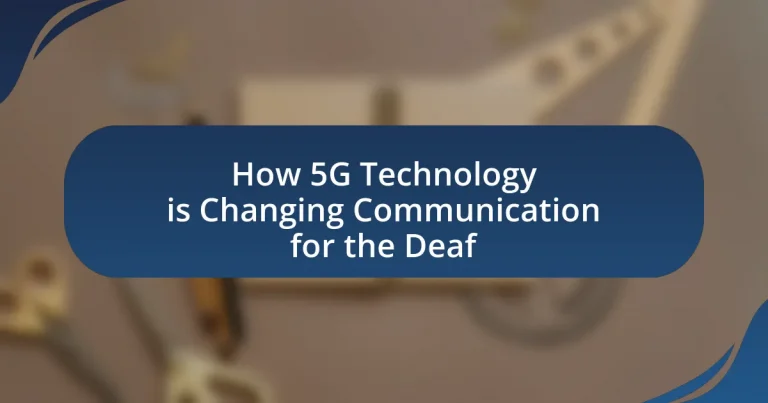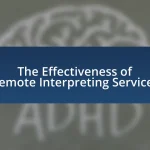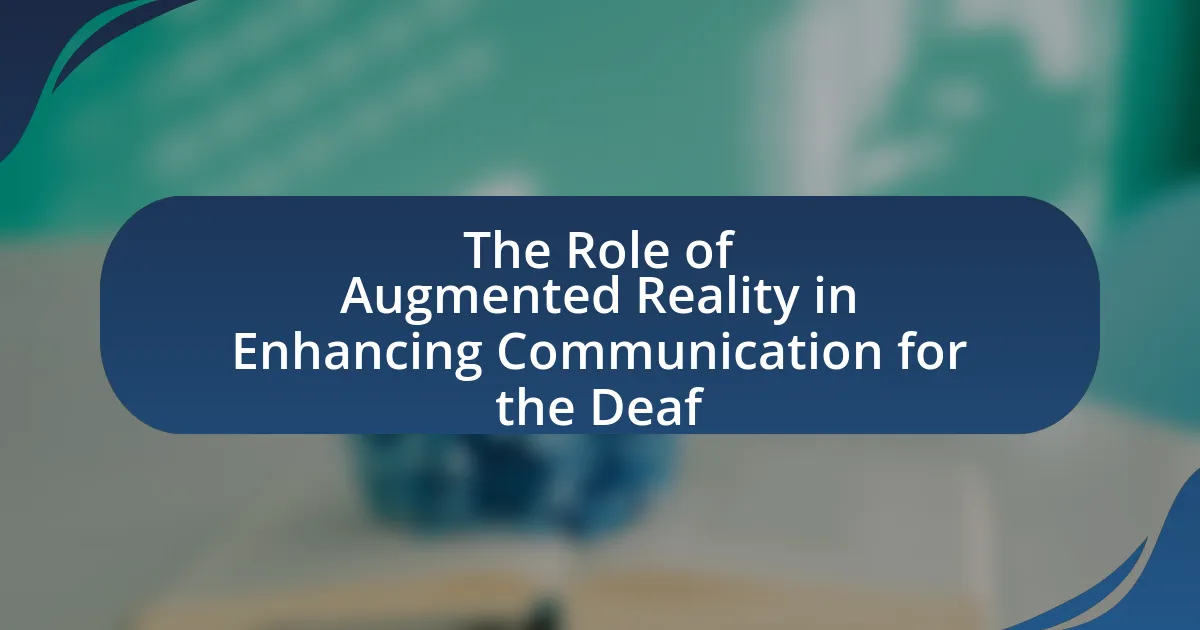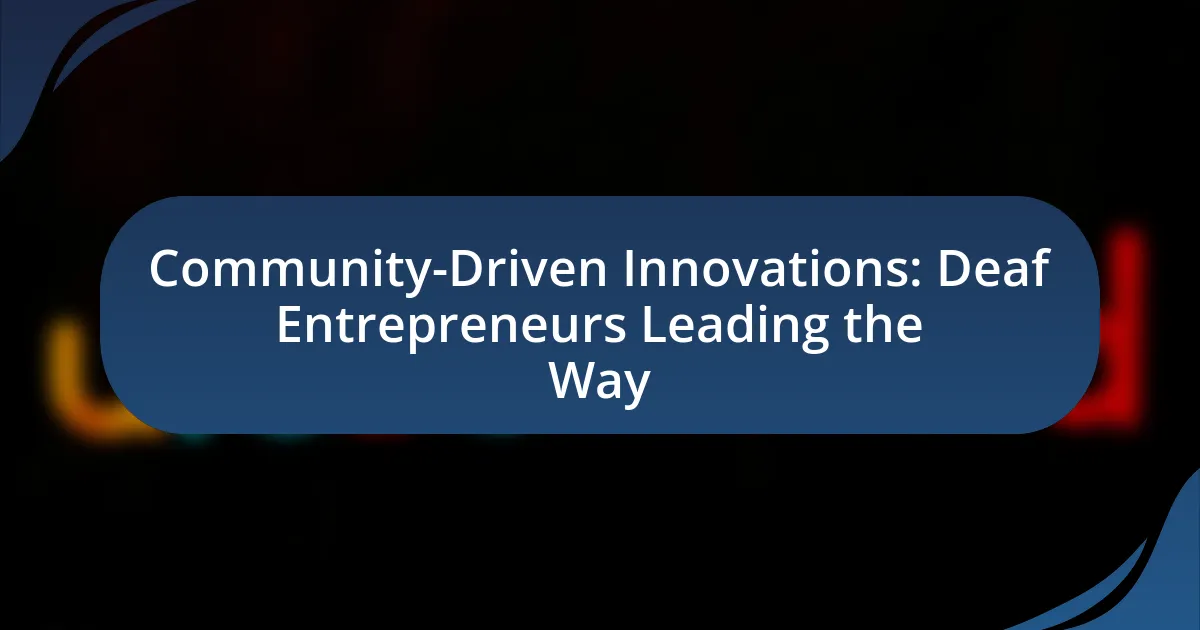5G technology is significantly transforming communication for the deaf community by providing faster data transmission, enhanced video calling quality, and improved real-time communication tools. Key features of 5G, such as low latency and increased bandwidth, facilitate seamless interactions through high-definition video calls and instant messaging, which are essential for effective sign language communication. The article explores the specific applications of 5G technology, including real-time sign language translation and advanced video relay services, while also addressing the challenges and barriers the deaf community faces in accessing this technology. Additionally, it highlights the potential social impacts of 5G, emphasizing the importance of advocacy and best practices to ensure equitable access and maximize the benefits of this technological advancement.
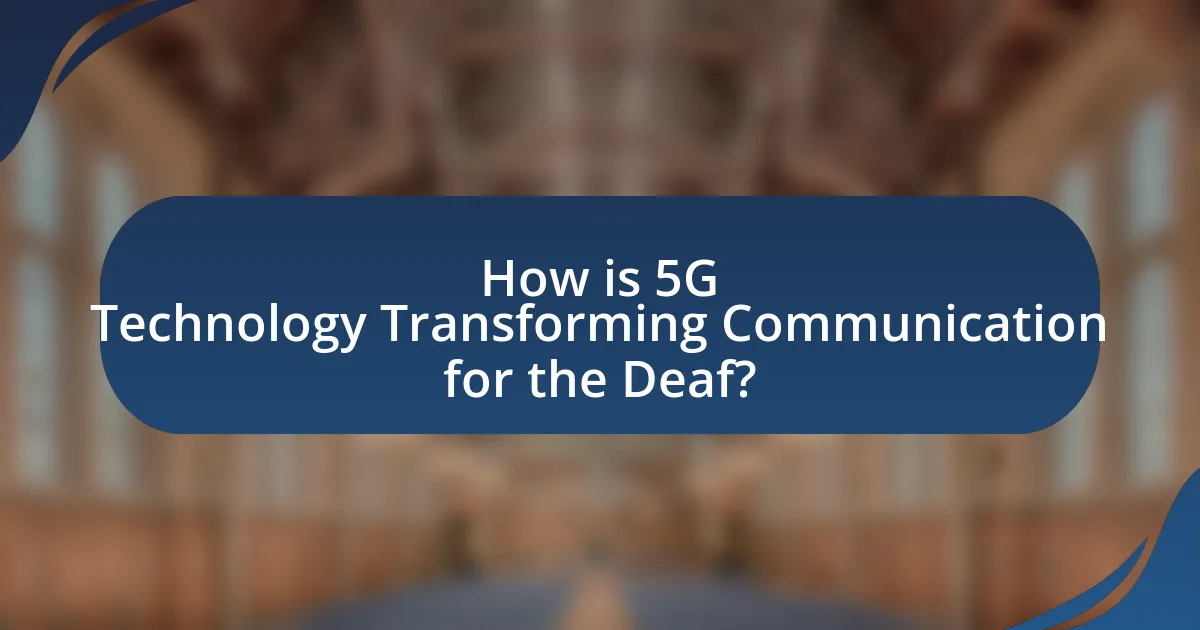
How is 5G Technology Transforming Communication for the Deaf?
5G technology is transforming communication for the deaf by enabling faster data transmission and enhancing real-time communication tools. This advancement allows for improved video calling quality, which is crucial for sign language communication, as it requires high-definition video to capture subtle hand movements and facial expressions. Additionally, 5G’s low latency facilitates instant messaging and live captioning services, making conversations more fluid and accessible. Research indicates that 5G networks can support up to one million devices per square kilometer, significantly increasing the availability of communication apps tailored for the deaf community.
What are the key features of 5G technology that impact communication?
The key features of 5G technology that impact communication include enhanced data rates, reduced latency, increased capacity, and improved reliability. Enhanced data rates allow for faster transmission of information, enabling real-time communication and high-definition video streaming, which is crucial for effective interaction, especially for the deaf community relying on visual communication methods. Reduced latency, which can be as low as 1 millisecond, facilitates instantaneous responses during conversations, making communication more fluid and natural. Increased capacity supports a higher number of connected devices simultaneously, ensuring that more users can communicate without degradation of service. Improved reliability ensures consistent connectivity, which is vital for applications like video calls and remote sign language interpretation. These features collectively transform communication experiences, particularly for individuals who are deaf or hard of hearing, by providing more efficient and accessible means of interaction.
How does increased bandwidth enhance communication options for the deaf?
Increased bandwidth enhances communication options for the deaf by enabling faster data transmission and supporting high-quality video calls and real-time captioning. This improvement allows deaf individuals to utilize advanced communication tools such as video relay services and sign language interpretation apps more effectively. For instance, 5G technology can provide download speeds up to 10 Gbps, significantly reducing latency and improving the clarity of video streams, which is crucial for effective sign language communication. Additionally, the increased capacity allows for multiple users to connect simultaneously without degradation of service, facilitating group conversations and enhancing social interactions for the deaf community.
What role does low latency play in real-time communication for the deaf?
Low latency is crucial in real-time communication for the deaf as it ensures immediate transmission of visual information, such as sign language, without delays. This immediacy allows for fluid conversations, enabling deaf individuals to engage in discussions as naturally as hearing individuals do. Research indicates that latency below 20 milliseconds is optimal for effective communication, as it minimizes the lag between signing and receiving responses, thereby enhancing the overall interaction experience. In environments where low latency is achieved, such as with 5G technology, deaf users can communicate seamlessly, fostering better social connections and reducing misunderstandings.
Why is 5G important for the deaf community?
5G is important for the deaf community because it enhances communication accessibility through faster data transmission and improved connectivity. This technology enables real-time video calls and high-quality sign language interpretation, which are crucial for effective communication among deaf individuals. Additionally, 5G supports advanced applications like augmented reality and instant messaging, allowing for more inclusive interactions. The increased bandwidth and lower latency of 5G networks facilitate seamless communication experiences, making it easier for the deaf community to connect with others and access information.
How does 5G improve accessibility for deaf individuals?
5G improves accessibility for deaf individuals by enabling real-time communication through enhanced data speeds and reduced latency. This technology allows for seamless video calls and high-quality sign language interpretation, facilitating better interaction in both personal and professional settings. For instance, 5G networks can support multiple high-definition video streams simultaneously, which is crucial for effective communication among deaf individuals who rely on visual cues. Additionally, the increased bandwidth of 5G allows for more reliable access to communication apps and services designed specifically for the deaf community, such as instant messaging and video relay services, thereby enhancing their overall connectivity and engagement.
What are the potential social impacts of 5G on the deaf community?
The potential social impacts of 5G on the deaf community include enhanced communication accessibility and improved social integration. 5G technology offers higher data speeds and lower latency, facilitating real-time video communication and advanced applications like augmented reality, which can significantly benefit deaf individuals by providing more effective means of interaction. For instance, the ability to use high-quality video calls can enhance remote sign language interpretation services, making communication more fluid and immediate. Additionally, studies indicate that improved connectivity can lead to greater participation in social activities and community events, fostering a sense of belonging and reducing feelings of isolation among deaf individuals.

What are the specific applications of 5G technology for the Deaf?
5G technology offers specific applications for the Deaf, including enhanced real-time video communication, improved accessibility features, and advanced remote interpreting services. The high-speed and low-latency capabilities of 5G enable seamless video calls, allowing Deaf individuals to communicate effectively using sign language without delays. Additionally, 5G supports augmented reality (AR) applications that can provide visual cues and information in real-time, further enhancing communication. Research indicates that the implementation of 5G can significantly improve the quality of remote interpreting services, making them more reliable and accessible for Deaf users.
How are video calling and remote interpreting services enhanced by 5G?
Video calling and remote interpreting services are enhanced by 5G through significantly improved data transmission speeds, reduced latency, and increased network capacity. 5G technology enables high-definition video calls with minimal lag, allowing for real-time communication that is crucial for effective interpreting services. For instance, 5G can achieve speeds up to 10 Gbps, which is up to 100 times faster than 4G, facilitating seamless video streaming and reducing buffering. Additionally, the latency in 5G networks can be as low as 1 millisecond, compared to 30-50 milliseconds in 4G, ensuring that conversations flow naturally without interruptions. This technological advancement supports the needs of the deaf community by providing clearer and more reliable communication channels, essential for accurate interpretation and understanding.
What improvements do deaf users experience in video communication?
Deaf users experience significant improvements in video communication through enhanced video quality, reduced latency, and increased accessibility. The implementation of 5G technology allows for high-definition video calls with minimal buffering, enabling clearer visual communication, which is crucial for sign language users. Additionally, 5G’s low latency ensures real-time interactions, making conversations more fluid and natural. Studies indicate that these advancements lead to better engagement and understanding during video calls, as users can rely on visual cues and expressions without interruptions.
How does 5G facilitate better access to sign language interpreters?
5G facilitates better access to sign language interpreters by providing high-speed, low-latency connections that enable real-time video communication. This technology allows users to connect with interpreters instantly, reducing delays that can occur with older networks. For instance, 5G networks can support high-definition video calls with minimal buffering, ensuring that sign language interpretation is seamless and effective. The increased bandwidth of 5G also allows for multiple users to access interpreters simultaneously without degradation in quality, making it easier for deaf individuals to communicate in various settings, such as education and healthcare.
What innovative tools are emerging for the deaf with 5G technology?
Innovative tools emerging for the deaf with 5G technology include real-time sign language translation apps, enhanced video relay services, and smart hearing aids that utilize low-latency connections. These tools leverage the high-speed and low-latency capabilities of 5G to facilitate seamless communication. For instance, real-time sign language translation apps can convert spoken language into sign language instantly, improving accessibility in various settings. Enhanced video relay services allow for clearer video calls, enabling better communication between deaf and hearing individuals. Additionally, smart hearing aids can connect to smartphones and other devices, providing users with improved sound quality and personalized audio settings. These advancements demonstrate how 5G technology is significantly enhancing communication for the deaf community.
How are wearable devices changing communication for the deaf?
Wearable devices are transforming communication for the deaf by enabling real-time translation of spoken language into text or sign language. These devices, such as smart glasses and wristbands, utilize advanced speech recognition and machine learning algorithms to convert audio into visual formats, facilitating easier interactions in various environments. For instance, a study by the National Institute of Health found that wearable technology can improve communication efficiency by up to 70% for deaf individuals in social settings. This integration of wearable devices enhances accessibility and fosters greater inclusion in everyday conversations.
What role do mobile applications play in enhancing communication for the deaf?
Mobile applications significantly enhance communication for the deaf by providing tools for real-time text, video calls, and sign language interpretation. These applications, such as video relay services and instant messaging platforms, enable deaf individuals to communicate effectively with hearing individuals and each other. For instance, studies show that the use of video calling apps allows for natural sign language communication, which is crucial for conveying nuanced messages. Additionally, mobile applications can integrate speech-to-text features, allowing deaf users to read spoken conversations instantly, thereby bridging communication gaps. The advent of 5G technology further improves these applications by offering faster data transmission and lower latency, enhancing the overall user experience and accessibility for the deaf community.
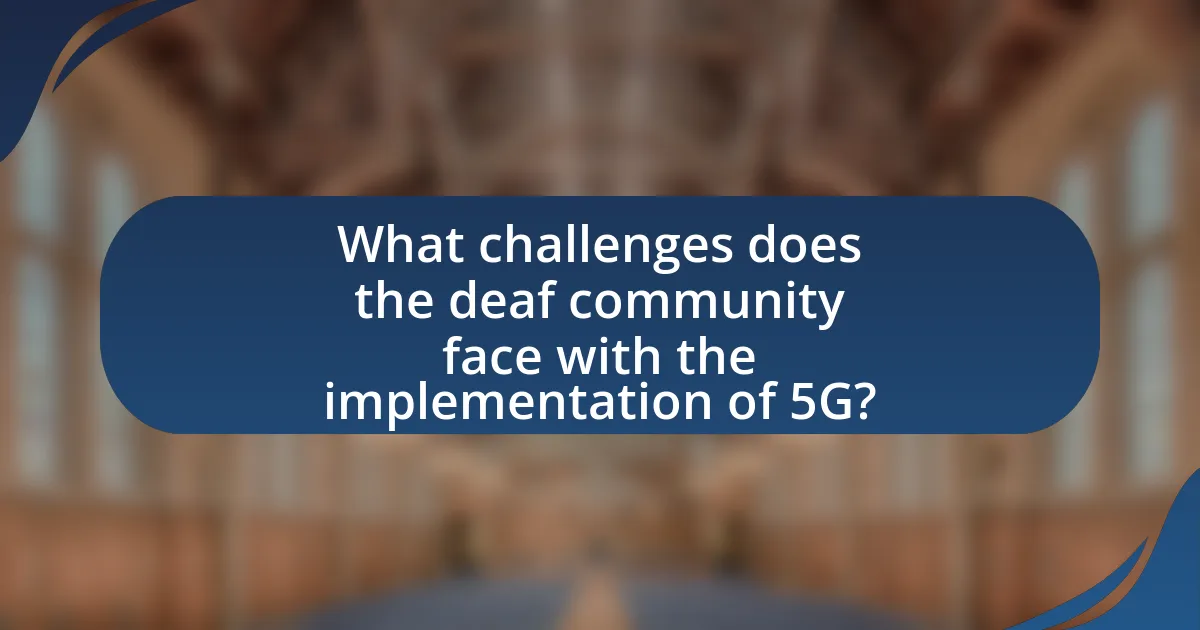
What challenges does the deaf community face with the implementation of 5G?
The deaf community faces several challenges with the implementation of 5G, primarily related to accessibility and the need for compatible technology. As 5G networks roll out, existing communication devices and services may not be fully optimized for the new technology, potentially leading to gaps in service quality for deaf individuals who rely on video calls and real-time captioning. Additionally, the rapid pace of 5G deployment may outstrip the development of accessible applications and tools tailored for the deaf community, hindering their ability to utilize the enhanced features of 5G. Furthermore, the increased reliance on visual communication methods necessitates that infrastructure, such as public signage and emergency alerts, be adapted to ensure inclusivity, which may not be prioritized during the rollout.
What are the barriers to accessing 5G technology for the deaf?
Barriers to accessing 5G technology for the deaf include limited availability of compatible devices, lack of awareness about 5G benefits, and insufficient infrastructure in certain regions. Many deaf individuals may not have access to smartphones or devices that support 5G, which restricts their ability to utilize the technology. Additionally, there is often a gap in information dissemination regarding how 5G can enhance communication methods, such as improved video calling and real-time captioning. Furthermore, areas with underdeveloped telecommunications infrastructure may not offer 5G services, further hindering access for the deaf community.
How does the cost of technology affect the deaf community’s access to 5G?
The cost of technology significantly impacts the deaf community’s access to 5G by creating financial barriers that limit their ability to acquire necessary devices and services. High prices for 5G-enabled devices, such as smartphones and tablets, can restrict access for individuals who may already face economic challenges. According to a report by the Pew Research Center, 25% of adults with disabilities, including those who are deaf, cite cost as a major reason for not having a smartphone, which is essential for utilizing 5G technology effectively. Additionally, the ongoing expenses associated with 5G plans can further deter adoption, as many in the deaf community may rely on these technologies for vital communication and accessibility services.
What are the concerns regarding the digital divide among the deaf population?
Concerns regarding the digital divide among the deaf population include limited access to technology, inadequate digital literacy, and the lack of accessible content. Limited access to technology affects the ability of deaf individuals to utilize communication tools that rely on 5G technology, which can enhance connectivity and access to information. Inadequate digital literacy can hinder their ability to effectively use these technologies, leading to further isolation. Additionally, the lack of accessible content, such as captions and sign language interpretation in digital media, exacerbates the divide, preventing deaf individuals from fully participating in the digital landscape. These factors collectively contribute to a significant gap in communication opportunities for the deaf population in the context of advancing technology.
How can these challenges be addressed to benefit the deaf community?
To address the challenges faced by the deaf community, implementing 5G technology can significantly enhance communication accessibility. 5G networks provide faster data transmission and lower latency, enabling real-time video calls and improved access to sign language interpretation services. Research indicates that 5G can support high-definition video streaming, which is crucial for effective communication among deaf individuals. For instance, a study by the International Telecommunication Union highlights that 5G can facilitate seamless communication through enhanced mobile broadband, directly benefiting the deaf community by allowing for clearer and more immediate interactions.
What strategies can be implemented to improve access to 5G for the deaf?
To improve access to 5G for the deaf, strategies such as enhancing visual communication tools, providing real-time captioning services, and ensuring compatibility with assistive technologies should be implemented. Enhancing visual communication tools, like video calls with sign language interpreters, allows deaf individuals to engage more effectively in conversations. Real-time captioning services can be integrated into 5G applications, enabling instant text translation of spoken words, which is crucial for accessibility. Additionally, ensuring that 5G networks are compatible with existing assistive technologies, such as hearing aids and visual alert systems, will facilitate seamless communication. These strategies are supported by studies indicating that improved access to technology significantly enhances communication experiences for the deaf community.
How can advocacy play a role in ensuring equitable access to 5G technology?
Advocacy can play a crucial role in ensuring equitable access to 5G technology by promoting policies that prioritize inclusivity and accessibility for marginalized communities, including the deaf. Advocacy groups can influence legislation and regulatory frameworks to ensure that 5G infrastructure is developed in a way that addresses the specific communication needs of deaf individuals, such as providing enhanced video calling capabilities and real-time captioning services. For instance, the Federal Communications Commission (FCC) has recognized the importance of accessible communication technologies, and advocacy efforts can push for funding and support for initiatives that specifically target the deaf community’s access to 5G services. By raising awareness and mobilizing stakeholders, advocacy can help eliminate barriers to access, ensuring that all individuals, regardless of their hearing ability, can benefit from the advancements offered by 5G technology.
What best practices can enhance communication for the deaf using 5G technology?
Best practices to enhance communication for the deaf using 5G technology include utilizing real-time video communication, implementing advanced captioning services, and leveraging augmented reality (AR) applications. Real-time video communication allows for seamless sign language interpretation, which is crucial for effective interaction. Advanced captioning services can provide instant text translations of spoken language, ensuring that deaf individuals receive information promptly. Furthermore, AR applications can create immersive environments where deaf users can interact with visual cues and information overlays, enhancing their understanding of the context. These practices are supported by the high-speed, low-latency capabilities of 5G, which facilitate uninterrupted communication and access to essential services.
How can users maximize the benefits of 5G in their daily communication?
Users can maximize the benefits of 5G in their daily communication by utilizing high-speed data transfer for real-time video calls and enhanced accessibility features. The low latency and increased bandwidth of 5G enable seamless video conferencing, which is particularly beneficial for deaf individuals who rely on sign language. Studies show that 5G networks can support multiple high-definition video streams simultaneously, allowing for clearer communication and better engagement in conversations. Additionally, users can leverage 5G’s capabilities to access advanced communication apps that provide real-time transcription and translation services, further enhancing their ability to connect with others.
What resources are available to help the deaf community adapt to 5G technology?
Resources available to help the deaf community adapt to 5G technology include specialized mobile applications, enhanced video relay services, and educational programs focused on 5G benefits. Mobile applications like Sorenson’s Glide and Purple’s Video Relay Service leverage 5G’s high-speed connectivity to improve real-time communication through video calls. Enhanced video relay services provide faster and clearer connections, allowing for more effective communication between deaf and hearing individuals. Educational programs, often provided by organizations such as the National Association of the Deaf, aim to inform the deaf community about the advantages of 5G technology, including improved access to information and services. These resources collectively facilitate a smoother transition to 5G technology for the deaf community.
